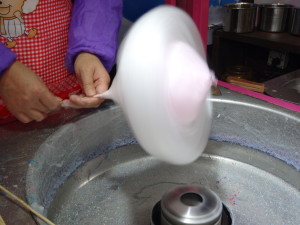Peter Lobner
While there are earlier claims to various forms of spun sugar, Wikipedia reports that machine–spun cotton candy (then known as fairy floss) was invented in 1897 by confectioner John C. Wharton and dentist William Morrison. If you sense a possible conspiracy here, you may be right. Cotton candy was first widely introduced at the 1904 St. Louis World Fair (aka the Louisiana Purchase Exposition).
As in modern cotton candy machines, the early machines were comprised of a centrifugal melter spinning in the center of a large catching bowl. The centrifugal melter produced the strands of cotton candy, which collected on the inside surface of the surrounding catching bowl. The machine operator then twirled a stick or paper cone around the catching bowl to create the cotton candy confection.
Two early patents provide details on how a cotton candy machine works.
The first patent for a centrifugal melting device was filed on 11 October 1904 by Theodore Zoeller for the Electric Candy Machine Company. The patent, US816055 A, was published on 27 March 1906, and can be accessed at the following link:
https://www.google.com/patents/US816055
In his patent application, Zoeller discussed the problems with the then-current generation of cotton candy machines, which were,
“…objectionable in that the product is unreliable, being more often scorched than otherwise, such scorching of the product resulting from the continued application of the intense heat to a gradually-diminishing quantity of the molten sugar. Devices so heated are further objectionable in that all once melted (sugar) must be converted into filaments without allowing such molten sugar to cool and harden, as (it will later be) scorched in the reheating.”
Zoeller describes his centrifugal melting device as:
“….comprising a rotatable vessel having a circumferential discharge-passage, and an electrically-heated band in said passage…”
His novel feature involved moving the heater to the rim of the centrifugal melting device.
A patent for an improved device was filed on 13 June 1906 by Ralph E. Pollock. This patent, US 847366A, was published on 19 March 1907, and can be accessed at the following link:
https://www.google.com/patents/US847366
This patent application provides a more complete description of the operation of the centrifugal melter for production of cotton candy:
“This invention relates to certain improvements in candy-spinning machines comprising, essentially, a rotary sugar-receptacle having a perforated peripheral band constituting an electric heater against which the sugar is centrifugally forced and through which the sugar emerges in the form of a line (of) delicate candy-wool to be used as a confection.
The essential object is to provide a simple, practical, and durable rotary receptacle with a comparatively large receiving chamber having a comparatively small annular space adjacent to the heater for the purpose of retarding the centrifugal action of the sugar through the heater sufficiently to cause the desired liquefaction of the sugar by said heater and to cause it to emerge in comparatively fine jets under high centrifugal pressure, thereby yielding an extremely fine continuous stream of candy-wool.”
This is the same basic process used more than a century later to make cotton candy at carnivals and state fairs today. The main problem I have with cotton candy sold at these venues is that it often is pre-made and sold in plastic bags and looks about as appetizing as a small portion of fiberglass insulation. Even when you can get it made on the spot, the product usually is just a big wad of cotton candy on a stick, as in the photo above, which can be created in about 30 seconds.
Let me introduce you to the best cotton candy in the world, which is made by a real artist at the Jinli market in Chengdu, China using the same basic cotton candy machine described above. As far as I can tell, the secret is working with small batches of pre-colored sugar and taking time to slowly build up the successive layers of what would become the very delicate, precisely shaped cotton candy flower shown below. This beautiful confection was well worth the wait, and, yes, it even tasted better than any cotton candy I’ve had previously.





